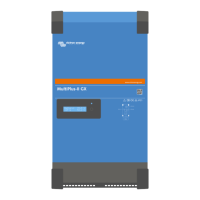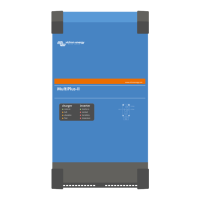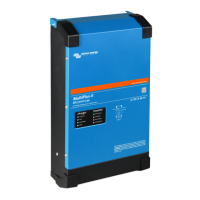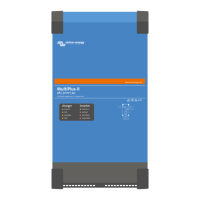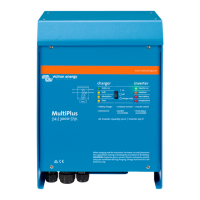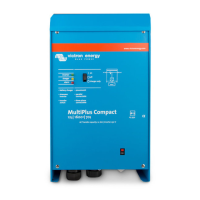13. Error Indications
With the procedures below, most errors can be quickly identified. If an error cannot be resolved, please refer to your Victron Ener-
gy supplier.
13.1. General error indications
Problem Cause Solution
No output voltage on AC-
out-2.
in inverter mode
Multi will not switch over to
generator or mains opera-
tion.
Circuit breaker or fuse in the AC-in input is open as a result of
overload.
Remove overload or short circuit on AC-out-1 or AC-out-2, and
reset fuse/breaker.
Inverter operation not initi-
ated when switched on.
The battery voltage is excessively high or too low. No voltage
on DC connection.
Ensure that the battery voltage is within the correct range.
'Low battery' The battery voltage is low. Charge the battery or check the battery connections.
'Low battery' (Shutdown) The converter switches off because the battery voltage is too
low.
Charge the battery or check the battery connections.
'Overload' The converter load is higher than the nominal load. Reduce the load.
'Overload' (Shutdown) The converter is switched off due to excessively high load. Reduce the load.
'Over Temperature' The environmental temperature is high, or the load is too high. Install the converter in cool and well-ventilated environment, or
reduce the load.
'Low Bat V Overload' (Shut-
down)
Low battery voltage and excessively high load. Charge the batteries, disconnect or reduce the load, or install
higher capacity batteries. Fit shorter and/or thicker battery ca-
bles.
'High DC Ripple' Ripple voltage on the DC connection exceeds 1,5Vrms. Check the battery cables and battery connections. Check
whether battery capacity is sufficiently high, and increase this if
necessary.
'DC Ripple Shutdown' The inverter is switched off due to an excessively high ripple
voltage on the input.
Install batteries with a larger capacity. Fit shorter and/or thicker
battery cables, and reset the inverter (switch off, and then on
again).
The charger does not oper-
ate.
The AC input voltage or frequency is not within the range set. Ensure that the AC input is between 185VAC and 265VAC,
and that the frequency is within the range set (default setting
45-65 Hz).
Circuit breaker or fuse in the AC-in input is open as a result of
overload.
Remove overload or short circuit on AC-out-1 or AC-out-2, and
reset fuse/breaker.
The battery fuse has blown. Replace the battery fuse.
The distortion or the AC input voltage is too large (generally
generator supply).
Turn the settings WeakAC and dynamic current limiter on.
The charger does not oper-
ate. 'Bulk Protection' shown.
is in 'Bulk protection' mode thus, the maximum bulk charging
time of 10 hours is exceeded. Such a long charging time could
indicate a system error (e.g. a battery cell short-circuit).
Check your batteries. NOTE: You can reset the error mode by
switching off and back on the . The standard factory setting of
the 'Bulk protection' mode is switched on. The 'Bulk protection'
mode can be switched off with help of VEConfigure only.
The battery is not complete-
ly charged.
Charging current excessively high, causing premature absorp-
tion phase.
Set the charging current to a level between 0.1 and 0.2 times
the battery capacity.
Poor battery connection. Check the battery connections.
The absorption voltage has been set to an incorrect level (too
low).
Set the absorption voltage to the correct level.
The float voltage has been set to an incorrect level (too low). Set the float voltage to the correct level.
The available charging time is too short to fully charge the bat-
tery.
Select a longer charging time or higher charging current.
The absorption time is too short. For adaptive charging this
can be caused by an extremely high charging current with re-
spect to battery capacity, so that bulk time is insufficient.
Reduce the charging current or select the 'fixed' charging char-
acteristics.
The battery is overcharged. The absorption voltage is set to an incorrect level (too high). Set the absorption voltage to the correct level.
Poor battery connection. Check the battery connections.
The float voltage is set to an incorrect level (too high). Set the float voltage to the correct level.
Poor battery condition. Replace the battery.
The battery temperature is too high (due to poor ventilation,
excessively high environmental temperature, or excessively
high charging current).
Improve ventilation, install batteries in a cooler environment,
reduce the charging current, and connect the temperature
sensor.
The charging current drops
to 0 as soon as the absorp-
tion phase initiates.
Defective battery temperature sensor Disconnect the temperature sensor plug in the . If charging
functions correctly after approximately 1 minute, the tempera-
ture sensor should be replaced.
The battery is over-heated (+50°C) Install the battery in a cooler environment
Reduce the charging current
Check whether one of the battery cells has an internal short
circuit
MultiPlus-II GX
24

